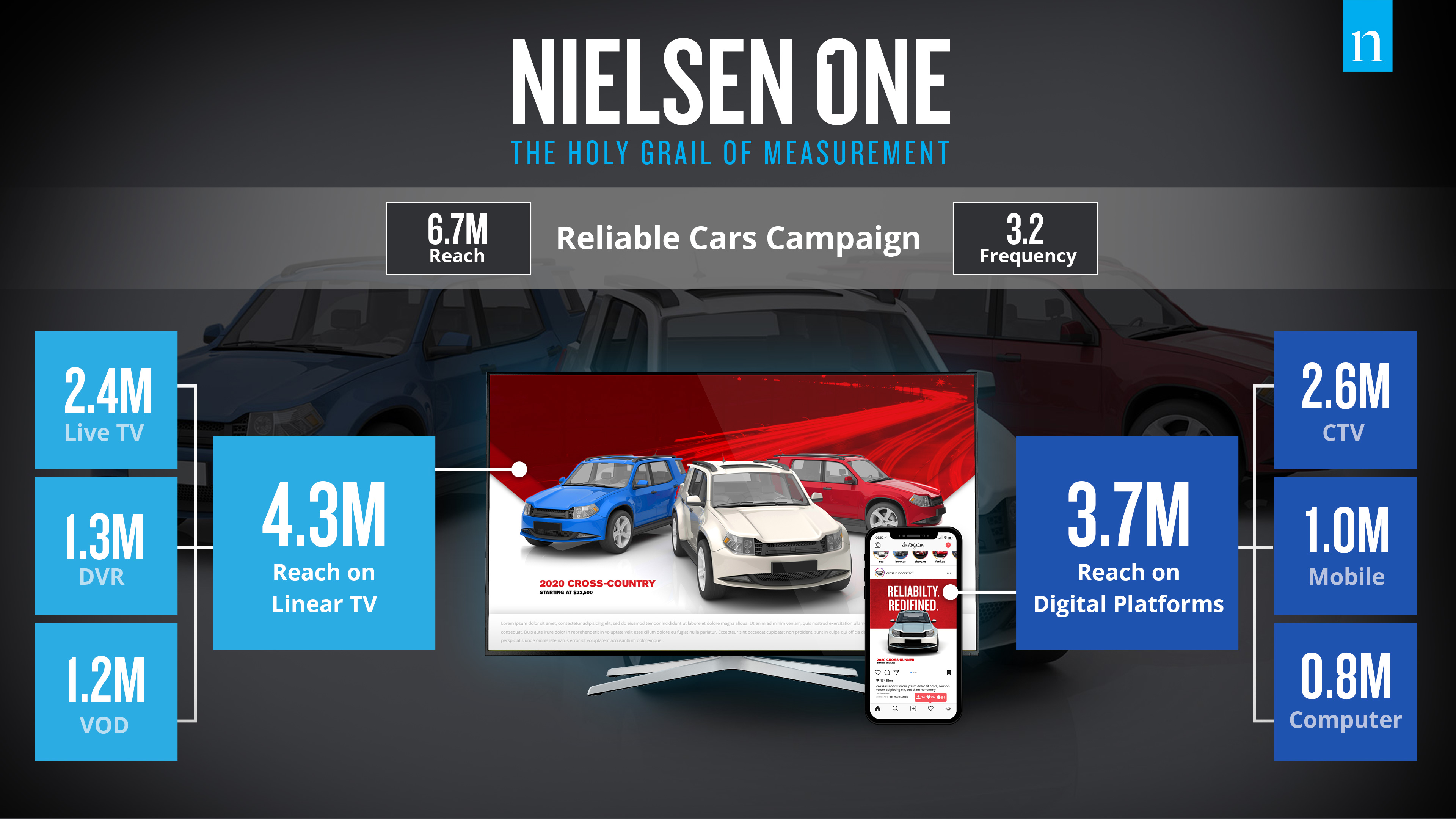Nielsen Sets Major Changes in Program, Ad Measurement
Cross-platform Nielsen One to launch in Q4 2022

As streaming transforms the media landscape, Nielsen is making sweeping changes in the way it measures the viewing of programs and commercials, altering the way $100 billion in video advertising is bought and sold.
Related: 'New Nielsen Introduced At Firm's Investor Day
Nielsen One will measure across linear, digital and streaming platforms, combine big data with its famous panel of Nielsen households, shift the focus from average minute per program to evaluating viewing on a second by second basis and move from a unit-based ad model to an impression based system that gives a separate audience number to individual commercials.
Related: Nielsen Readies Big Data Metrics for TV Advertising
Nielsen has been discussing its plans with its clients over the past several months, including at a national client meeting in October. Last month Nielsen announced plans to incorporate data from millions of cable set top boxes and smart TV sets to enable it to better measure addressable advertising.
Related: Nielsen Adds STB, Smart TV Data for Addressable Ads
Nielsen plans to launch Nielsen One in the fourth quarter of 2022. At that point it will continue to produce its current ratings data as well. The company expects the industry to fully transition to its cross-media metrics by the Fall 2024 TV season.
Broadcasting & Cable Newsletter
The smarter way to stay on top of broadcasting and cable industry. Sign up below
“We’re kind of turning everything upside down,” said Scott N. Brown, who in August was named head of audience measurement at Nielsen.
With the new system Nielsen will still produce ratings that say how many people watched a show, but it will add up viewing on linear TV, streaming and digital platforms. “Every company we talk to has a streaming first or digital first strategy,” Brown said. “We think the industry is going to demand a cross-media set of data to buy and sell on and the resounding feedback is that the industry is ready.”

The bigger changes come with advertising. The familiar C3 and C7 commercial ratings, which measure the average commercial minute viewing in shows whether that viewing was live or took place on a delayed basis via VOD or DVR, will be replaced. The new system measures how many impressions each individual spot generated and provides data on a second-by-second basis. That means spots placed in different parts of a show, or even in different positions within a commercial pod, will have different audiences and values to advertisers.
The new systems will help buyers and advertisers calculate the de-duplicated reach and frequency of their campaigns as they plan and buy and help evaluate them afterwards.
Brown said that he expects that age and sex demographic audiences will remain the primary way commercials are bought, sold and guaranteed, “We will report age and gender, but we’re also going to be going beyond that to show on-target percentage, allowing advertisers to understand how their media is performing,” he said.
For some in the industry the changes are welcome, but are not coming soon enough.
“There are some massive changes in how people are accessing and consuming content that have a dramatic impact on how the measurement services work,” said Adam Gerber, Global Chief Media Officer, at GroupM’s Essence.
What the industry wants from Nielsen is an audience currency that is flexible and can be used to target demographic, behavioral or other types of audiences.
“Would I have loved for this to have been done five year ago when we all saw this coming? Of course? But it’s important Nielsen is taking this step.”
Gerber said both Nielsen and the advertising world will have a lot of work to do to bridge the gap between the digital world, where advertisers buy a certain number of impressions, and the linear TV world in which advertisers buy a 30 second spot and estimate how many people will see it.
“Getting exact commercial ratings changes the way we do our deals and the way we think about how we work with video suppliers and develop schedules,” Gerber said. But while getting that level granularity will be great, “think about all the changes that requires to the systems we use, the planning tools, the stewardship tools, the billing tools. There’s a lot of plumbing we rely on to manage the traditional linear world that all of a sudden has to be reconfigured and rethought.”
Related: Nielsen Sheds Unit as it Gears Up for Big Data
Nielsen has been gathering large data sources in order to provide granular data on video viewing. That includes working with cable operators, TV set makers and the big digital platforms. Brown says more data deals are in the works and he expects them to close early next year.
But Nielsen will also continue to use its panels to make sure its big data is telling the truth about how people are consuming media and to make sure their measurement is unbiased and inclusive.
“We’re rolling out a big data plus panel approach, Brown said. “All census data sources have some sort of bias and a panel will never be large enough to measure the amount of fragmentation that’s happening.”
Related: Nielsen Unveils Post-Cookie System for ID Resolution
Nielsen will be unifying its panels. Its core TV panel will also be asked to add devices that measure streaming, mobile and computer video viewing. That panel of 120,000 people will be merged with the portable people meter panel--another 70,000 people-- Nielsen uses to measure radio and other audio media and out-of home viewing.
“That means that cross-platform measurement will happen in every single panel home that Nielsen has,” Brown said.
That will require changes to how Nielsen recruits it panels, he added.
For its customers, Nielsen will be launching a new user unified interface that gives subscribers data about TV, streaming, mobile and other media all in a single dashboard.
In 2019, Nielsen moved to a cloud infrastructure, increasing its ability to share data with clients. Brown said Nielsen has a Media Data Engine that it will be piloting with certain clients. It allows them to pipe directly and securely into the cloud so they can do deep analytics on their own.
Nielsen is also going to have computer interfaces that plug into transactional systems like those run by Mediaocean and The Trade Desk.
Brown said one thing clients ask about is how much the new system will cost. (Most think it is already too expensive.)
Related: Nielsen Turns 3Q Profit as Revenue Declines
He noted that Nielsen has been making an investment in data but, pricing is still a work in progress. “If we can make advertising just a little bit more efficient, then it should pay for itself and those discussions are easier.”
Brown said Nielsen will be putting together a cross media industry working committee comprised of the networks, the digital walled gardens, agencies and marketers. The group will discuss issues like defining impressions in a comparable way across digital and linear and figuring out how the changes in measurement will impact the demand side platforms and sell side platforms that administer the buying and selling process across television and digital media.
Essences’ Gerber said the new measurement system will provide an immediate jolt by enabling the inserting of addressable ads into network’s linear feeds. Linear advertisers will be able to ascertain the quality of the viewers they’re getting after other advertisers cherry-pick the target audiences they want.
“This will also support things like better frequency management for campaigns and help the move to advanced audience segments," he said.
“So much of the business is going to be impacted, from the tools we use to the way that we negotiate, to the way that suppliers manage their portfolios,” Gerber said. We can either can win as an industry through compromise and getting to the next stage of measurement or where we can kind of fight with each other and and have someone else disintermediate us all, he said. “That's the challenge we've got. We've got to figure out how to work together.”
Jon has been business editor of Broadcasting+Cable since 2010. He focuses on revenue-generating activities, including advertising and distribution, as well as executive intrigue and merger and acquisition activity. Just about any story is fair game, if a dollar sign can make its way into the article. Before B+C, Jon covered the industry for TVWeek, Cable World, Electronic Media, Advertising Age and The New York Post. A native New Yorker, Jon is hiding in plain sight in the suburbs of Chicago.

